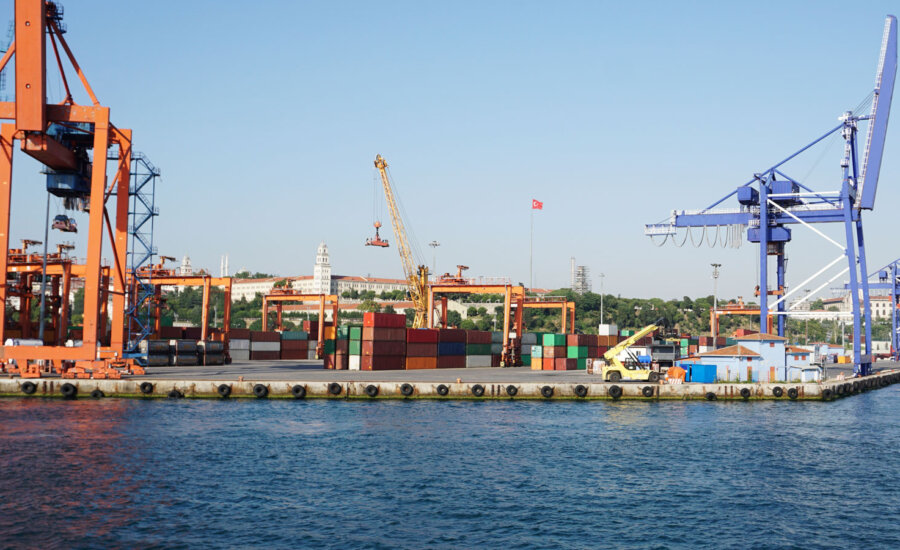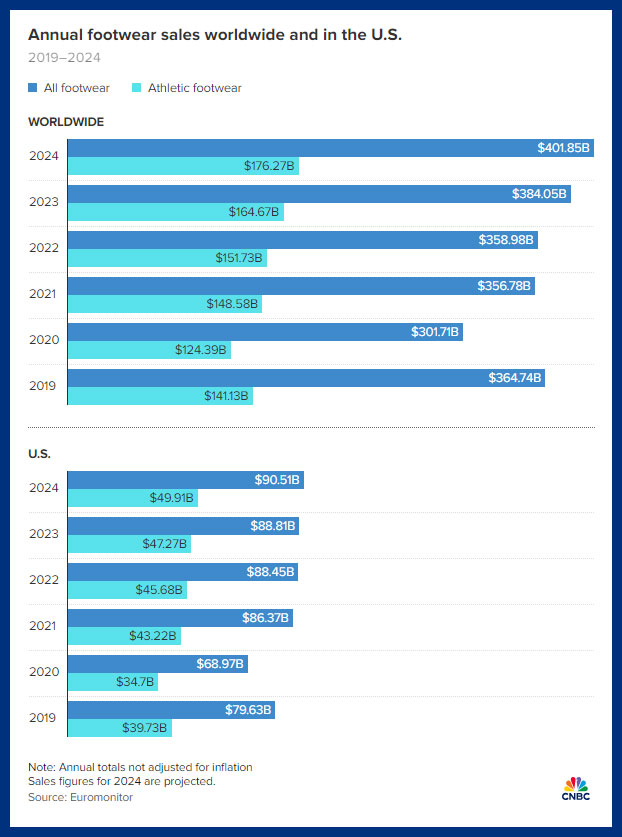Making sense of the markets this week: October 6, 2024
National Bank moves up, Carnival cruises on while Nike lags, dockworker strike postponed until January, and utility stocks are back in vogue.
Advertisement
National Bank moves up, Carnival cruises on while Nike lags, dockworker strike postponed until January, and utility stocks are back in vogue.

Kyle Prevost, creator of 4 Steps to a Worry-Free Retirement, Canada’s DIY retirement planning course, shares financial headlines and offers context for Canadian investors.
According to this week’s earnings, we would rather cruise than run—when wearing Nike shoes at least.
This is what came out of the earnings reports this week. Both Nike and Carnival report in U.S. dollars.
A pair of earnings beats led to surprisingly muted market sentiment. Carnival set new revenue records for the quarter and boosted its future forecast for the third time this year. Carnival CEO Josh Weinstein stated that revenues were up mostly to improved profit margins on board each ship (as opposed to simply running more cruises).

Shareholders had a muted response on that day, with the stock price down slightly. That said, it might simply be that the good news was “baked in” as Carnival’s share price has been on a tear. It’s up over 36% in the last 12 months.
Nike continued its surprising free fall despite solid profit numbers for the quarter. Shares fell about 5% in after-hours trading following the earnings announcement, and are now down about 23% year to date. The company seems to be in a transition mode as it postponed its investor day due to onboarding the new CEO. John Donahoe is stepping down and will be replaced by Elliott Hill on October 14.
Nike’s earnings report stated that it expects overall revenue to be down 8% to 10% next quarter, and that order books for spring were down as well. Nike’s strategy of focusing on direct online sales as opposed to the traditional wholesaler model has been criticized. It doesn’t help that the U.S. sneaker market looks to have plateaued for the time being.
One more thing to note: It appears Elon Musk has successfully burned about USD$35 billion. That means X is now worth only about 20% of what he paid for Twitter. Musk remains the richest person in the world. So, to put that number in perspective: His investment in the social platform has already lost the equivalent of what Barrick Gold is worth (the 21st largest company in Canada and the second-largest gold mining company in the world).

Get up to 4.00% interest on your savings without any fees.

Lock in your deposit and earn a guaranteed interest rate of 3.55%.

Earn 3.7% for 7 months on eligible deposits up to $500k. Offer ends June 30, 2025.
MoneySense is an award-winning magazine, helping Canadians navigate money matters since 1999. Our editorial team of trained journalists works closely with leading personal finance experts in Canada. To help you find the best financial products, we compare the offerings from over 12 major institutions, including banks, credit unions and card issuers. Learn more about our advertising and trusted partners.
For many years, Canada has boasted a Big Five list for the large banks. RBC and TD have been two of Canada’s largest companies for decades, with BMO, Scotiabank and CIBC also ranking within in the top 20. Some say it’s the Big Six, to include National Bank of Canada. But we may soon have to shelve the Big Five for good, as National Bank’s planned takeover of Canadian Western Bank (CWB) was recently approved by the Competition Bureau of Canada.
The approval was by no means guaranteed, as the Canadian banking sector is pretty top heavy with the Big Five holding the majority of market share. Given RBC’s takeover of HSBC Canada earlier this year, the government seems to favour of these large financial institutions getting even bigger.
Here are a five reasons why this takeover is noteworthy for Canadian investors:
The deal now needs final approval from the Office of the Superintendent of Financial Institutions (OSFI) and the Minister of Finance, with hopes it will close in the next year.
You can read more about National Bank, as it was my pick as 2024 Canadian Dividend King on MillionDollarJourney.com.
Much like the brief railways strike in Canada earlier this year, a longshoremen strike in the United States has the potential to bring the U.S. economy to its knees. Nearly 25,000 longshoremen (or dockworkers) walked off the job on Tuesday, and the staff at the rest of the American commercial port dockworkers refused to unload their cargo, in solidarity with their east-coast colleagues. Late Thursday, it was announced that the strike had ended for now, with negotiations resuming in January, well after the election. Sources told Reuters it was agreed to a wage hike of 62% over six years
The strike threatened to directly affect 14 ports on the eastern side of the U.S. The International Longshoremen’s Association (ILA) was asking for a 77% raise. It rejected the U.S. Maritime Alliance proposal of a 50% raise. While the current top hourly wage equates to about USD$81,000 per year (at 40 hours per week), about a third of New York’s Longshoremen made USD$200,000 or more last year, after accounting for overtime.
Some economists suggested these work stoppages could have cost up to USD$5 billion per day. Upstream effects would have meant more than 100,000 people out of work, and may yet if the strike is restarted early in the new year.
The strike “coincidentally” (we’ll leave it to you to decide) was occurring during a politically-sensitive time for the current government, given November’s election. While organized labour has traditionally been a pillar of support for the Democratic Party, current membership has been moving toward the Republican Party for this election cycle. President Joe Biden is in a bit of a bind, as he has repeatedly called himself the most labour-friendly president in American history, but he also would want to minimize disruptions and inflation pressures during this key pre-election period. Before Thursday’s apparent resolution, Biden said he wouldn’t intervene in the strike, citing increased profits by shipping companies as rationale for why they should be able to finalize the deal.
Some experts speculate the real sticking point in negotiations isn’t about wages but protection from automation. The ILA refused to allow its members to work on automated vessels docking at U.S. ports. As a result, American ports are getting more and more inefficient, ranking not only behind ports in China, but also Colombo, Sri Lanka. (The Container Port Performance Index is put together annually by The World Bank and S&P Global Market Intelligence.)
For reference, the highest-rated port in Canada is Halifax, listed at 108th in the world. Halifax’s port efficiency was well behind not only Sri Lanka, but also economic powerhouses like Tripoli, Lebanon. To give further Canadian context, Montreal is 348th, and Vancouver is 356th, which is just ahead of Benghazi, Libya.
Something tells me that negotiating for USD$300,000-per-year dockworkers is not going to help these North American efficiency numbers. The higher salaries get, the more attractive automation strategies will quickly become. Clearly there will be an eventual reckoning. In the meantime, for at least one more important presidential news cycle, dockworkers will be able to extract large wage gains as they hold the broader economy hostage.
As income-oriented Canadian investors start to grow less enamoured of high-interest savings accounts and guaranteed investment certificates (GICs), the dividend yields of dependable North American utility stocks should begin to look more attractive. Given how quickly interest rates are likely to fall, it’s clear that there is a stampede of investors heading for the stocks of utility companies.
The iShares U.S. Utilities ETF (IDU/NYSE) is up more than 30% year to date, and the iShares S&P/TSX Capped Utilities Index ETF (XUT/TSX) is up about 15% year to date. (Check out MoneySense’s ETF screener for Canadian investors.)
Most of the time utilities (especially those in sectors regulated by federal and local governments) are perceived as “boring.” Sure, the profits are dependable, but if the government is going to determine how much is paid for electricity or natural gas, then a company’s profit margins are tough to change. The dividend income is dependable. But that’s really the whole sales job in a nutshell.
Lately, however, due to AI’s electricity needs and possible AI-fuelled efficiency increases, utilities have been getting some glowing press. Falling interest rates mean that annual interest costs will drop (utilities often have to borrow a lot of money to complete big projects). Meanwhile, Canadian investors looking for safe cash flow are pouring in. Utility stocks make up about 4% of the S&P/TSX Composite Index. The largest utility companies—such as Fortis, Emera, Hydro-One and Brookfield Infrastructure—are some of Canada’s largest companies.
Some of the same income-oriented investors who like utility stocks may also be interested in two new exchange-traded funds (ETFs) that J.P. Morgan Asset Management Canada just launched. The JPMorgan US Equity Premium Income Active ETF (JEPI/TSX) and the JPMorgan Nasdaq Equity Premium Income Active ETF (JEPQ) use options strategies to “juice” the income already provided by higher-dividend-yielding stocks.
Personally, I’m not a fan of these types of ETFs, as they sacrifice way too much upside in order to squeeze out a few-tenths-of-a-per-cent more yield.
I want to make sure you’re aware that registration has started for the 2024 Canadian Financial Summit. It’s a free online summit, so make sure you reserve your spot. It’s first come, first serve. MoneySense’s own Lisa Hannam, Jonathan Chevreau, Jaclyn Law and Michael McCullough are speaking, so don’t miss out.
Share this article Share on Facebook Share on Twitter Share on Linkedin Share on Reddit Share on Email